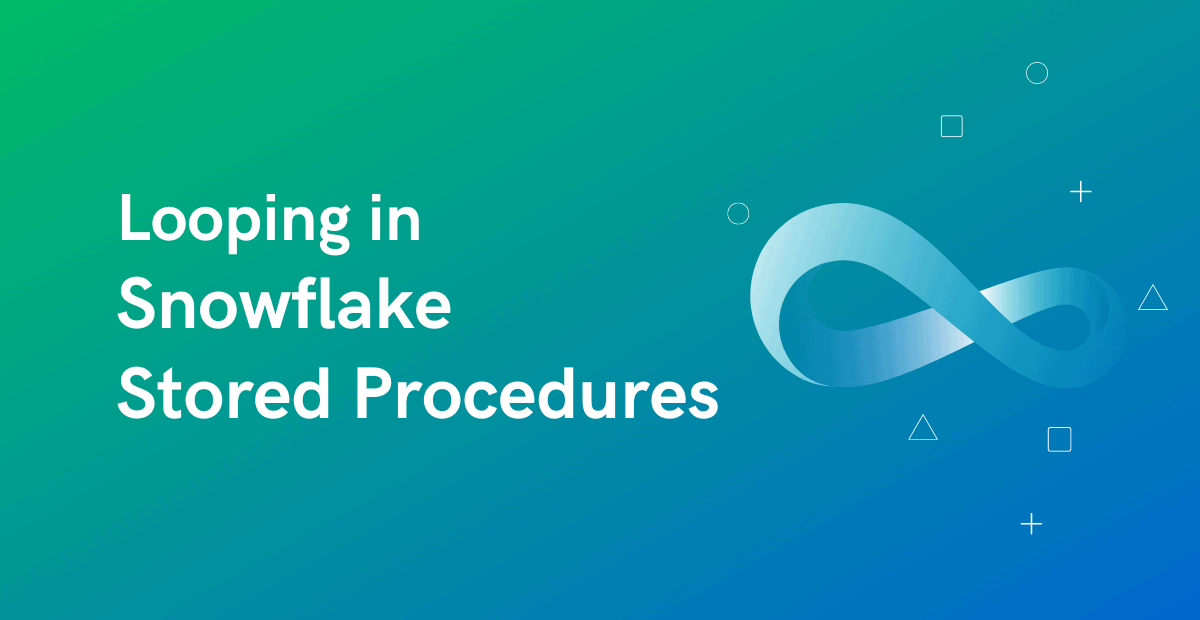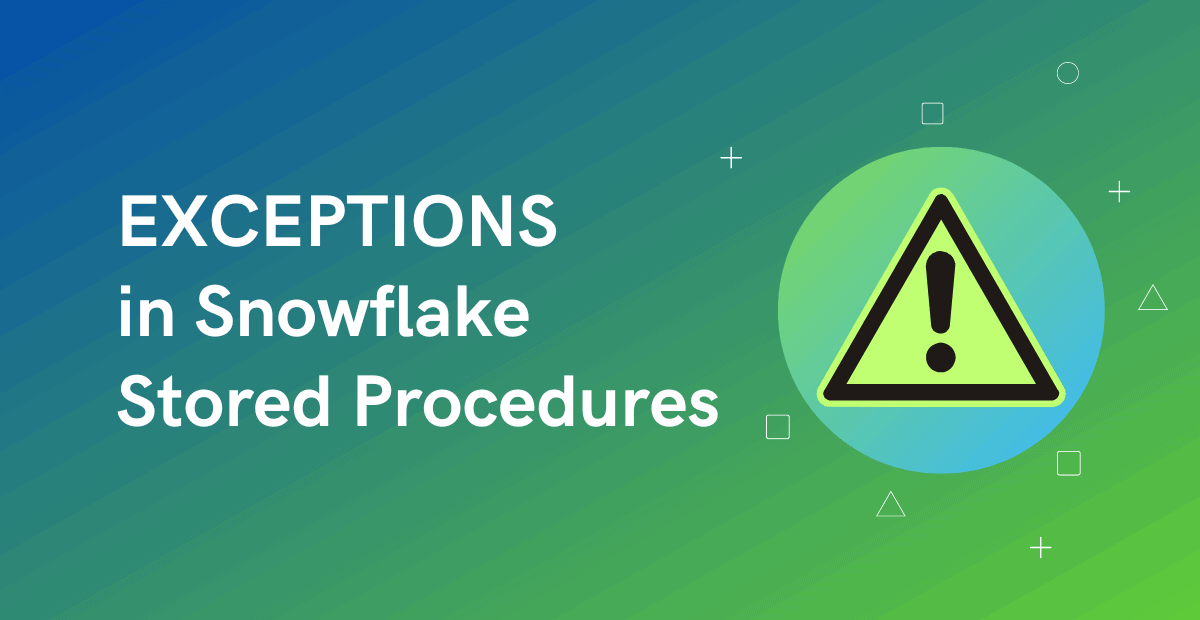1. Introduction
An exception occurs during the execution of a procedure when an instruction is encountered which cannot be executed at run-time due to an error. Apart from run-time errors, Snowflake also lets you raise an exception manually whenever an undesired result is encountered to prevent the next lines of code from executing.
Snowflake also allows catching an exception for the errors that can occur in our code and handle the exception by defining exception handlers for each exception. These exception handlers contain the code that needs to be executed when that particular exception arises.
In this article let us discuss how to declare, raise and catch exceptions in Snowflake Stored Procedures.
2. Declaring an Exception in Snowflake Stored Procedures
The user-defined Exception needs to be declared in the DECLARE section of the stored procedure.
The syntax to declaring an exception in DECLARE section of the stored procedure is as shown below.
DECLARE
<exception_name> EXCEPTION ( <exception_number>, '<execption_message>') ;Exception_name:
The name of the user-defined exception provided by the user.
Exception_Number:
This is the number to uniquely identify the exception which should be between -20000 to -20999. Same number should not ne user for multiple exceptions with in the same procedure.
If you don’t not specify a number for the exception, the default value used is -20000.
Exception_Message:
This is the text that describes the exception. The text must not contain any double quote characters.
The below is an example of declaring exceptions with and without exception number and message.
DECLARE
MY_EXCEPTION1 EXCEPTION;
MY_EXCEPTION2 EXCEPTION(-20000,'Raised user defined exception MY_SP_EXCEPTION1.');3. Raising an Exception in Snowflake Stored Procedures
An exception can be raised manually by executing the RAISE command.
The syntax to raise an exception using RAISE command in the BEGIN..END section of the stored procedure is as shown below.
RAISE <exception_name>;The below is a simple example showing an exception being raised using RAISE command.
CREATE OR REPLACE PROCEDURE sp_raise_exception()
RETURNS VARCHAR
LANGUAGE SQL
AS
$$
DECLARE
MY_SP_EXCEPTION EXCEPTION;
BEGIN
RAISE MY_SP_EXCEPTION;
END;
$$
;The output of the stored procedure is as follows.
CALL sp_raise_exception();
The below is another simple example showing an exception being raised using RAISE command where exception number and message are defined.
CREATE OR REPLACE PROCEDURE sp_raise_exception()
RETURNS VARCHAR
LANGUAGE SQL
AS
$$
DECLARE
MY_SP_EXCEPTION EXCEPTION(-20001, 'Raised user defined exception MY_SP_EXCEPTION.');
BEGIN
RAISE MY_SP_EXCEPTION;
END;
$$
;The output of the stored procedure is as follows.
CALL sp_raise_exception();
Note that the exception number and message are displayed as per the exception definition and are different from previous example.
4. Catching an Exception in Snowflake Stored Procedures
Whenever we are raising and exception using the RAISE command, the job fails providing the information of the error.
Instead of letting the job fail, we can also handle the exception by catching it using the EXCEPTION block of the stored procedure.
The syntax to catch an exception using the EXCEPTION block in the stored procedure is as shown below.
BEGIN
…
EXCEPTION
WHEN <exception_name> THEN
<statement>;
END;The below is an example showing how to catch an exception using EXCEPTION block in stored procedures.
CREATE OR REPLACE PROCEDURE sp_raise_exception()
RETURNS VARCHAR
LANGUAGE SQL
AS
$$
DECLARE
MY_SP_EXCEPTION EXCEPTION(-20001, 'Raised user defined exception MY_SP_EXCEPTION.');
BEGIN
RAISE MY_SP_EXCEPTION;
EXCEPTION
WHEN MY_SP_EXCEPTION THEN
RETURN 'Raised user defined exception MY_SP_EXCEPTION';
END;
$$
;The output of the stored procedure is as follows.
CALL sp_raise_exception();
5. Built-in Exception Variables in Snowflake Stored Procedures
Snowflake provides some built-in variables which provides information about the exceptions raised in the stored procedure.
The three built-in exception variables are as follows:
- SQLCODE
- SQLERRM
- SQLSTATE
5.1. SQLCODE
The SQLCODE variable captures the exception number defined for the user defined exception while declaring.
5.2. SQLERRM
The SQLERRM variable captures the error message defined for the user defined exception while declaring.
5.3. SQLSTATE
The SQLSTATE variable is a 5-character code which indicates the return code of a call which accords to ANSI SQL SQLSTATE . Snowflake uses additional values beyond those in the ANSI SQL standard.
The below is an example which shows the usage of built-in exception variables in a stored procedure.
CREATE OR REPLACE PROCEDURE sp_raise_exception(var number)
RETURNS VARCHAR
LANGUAGE SQL
AS
$$
DECLARE
my_sp_exception1 EXCEPTION (-20001, 'Raised user defined exception MY_SP_EXCEPTION1.');
my_sp_exception2 EXCEPTION (-20002, 'Raised user defined exception MY_SP_EXCEPTION2.');
BEGIN
IF (var=0) THEN
RAISE my_sp_exception1;
ELSEIF (var=1) THEN
RAISE my_sp_exception2;
END IF;
RETURN var;
EXCEPTION
WHEN my_sp_exception1 THEN
RETURN SQLSTATE||':'||SQLCODE||':'||SQLERRM;
WHEN my_sp_exception2 THEN
RETURN SQLSTATE||':'||SQLCODE||':'||SQLERRM;
END;
$$
;In the above stored procedure
- There are two user defined exceptions
my_sp_exception1andmy_sp_exception2. - If the value of the variable
var=0, themy_sp_exception1is raised. - If the value of the variable
var=1, themy_sp_exception2is raised. - If the value of the variable
varis other than 0 and 1, the value ofvaris returned. - For each exception, the details are captured using the built-in variables in the EXCEPTION block of the stored procedure.
The output of the stored procedure with built-in variables for various inputs is as follows.
CALL sp_raise_exception(0);
CALL sp_raise_exception(1);
CALL sp_raise_exception(3);
6. Built-in Exceptions in Snowflake Stored Procedures
Snowflake provides built-in exceptions which are able to define the cause of the error and helps in catching the error. These built-in exceptions can be used along with user defined exceptions in the stored procedures.
The built-in exceptions in the Snowflake stored procedures are as follows
6.1. STATEMENT_ERROR
This exception indicates the error associated with executing a SQL statement. For example, if you perform any operation on a table which does not exist, this exception is raised.
6.2. EXPRESSION_ERROR
This exception indicates an expression-related error. This error is raised, for instance, dividing by zero or if you construct an expression that evaluates to a VARCHAR and try to assign its value to a FLOAT.
6.3. OTHER
Though this exception do not capture only one particular error, this helps in catching the exceptions that are not specified in the stored procedure.
The below is an example of a stored procedure capturing the error from a delete statement using built-in exception STATEMENT_ERROR.
CREATE OR REPLACE PROCEDURE sp_purge_data()
RETURNS VARCHAR
LANGUAGE SQL
AS
$$
BEGIN
DELETE FROM emp;
EXCEPTION
WHEN STATEMENT_ERROR THEN
RETURN 'STATEMENT_ERROR:'||SQLSTATE||':'||SQLCODE||':'||SQLERRM;
END;
$$;The output of the stored procedure is as follows.
CALL sp_purge_data();
The below is an example of a stored procedure capturing the error using built-in exception EXPRESSION_ERROR.
CREATE OR REPLACE PROCEDURE sp_expression_error()
RETURNS VARCHAR
LANGUAGE SQL
AS
$$
DECLARE
var1 FLOAT;
var2 VARCHAR DEFAULT 'Some text';
BEGIN
var1 := var2;
RETURN var1;
EXCEPTION
WHEN EXPRESSION_ERROR THEN
RETURN 'STATEMENT_ERROR:'||SQLSTATE||':'||SQLCODE||':'||SQLERRM;
END;
$$;The output of the stored procedure is as follows.
CALL sp_expression_error();
Note that we have not declared any exception in the above examples and the error information is captured using a built-in exceptions.
In both the above two examples, you can replace the built-in exception with OTHER and it will still capture the error information. Not just the built-in exceptions, the OTHER exception catches any user-defined exception which is declared but not specified in EXCEPTION block.
The below is an example of a stored procedure capturing the error using built-in exception OTHER.
CREATE OR REPLACE PROCEDURE sp_demo_other()
RETURNS VARCHAR
LANGUAGE SQL
AS
$$
DECLARE
var1 NUMBER;
BEGIN
var1 := 1/0;
RETURN var1;
EXCEPTION
WHEN OTHER THEN
RETURN 'OTHER_ERROR:'||SQLSTATE||':'||SQLCODE||':'||SQLERRM;
END;
$$;The output of the stored procedure is as follows.
CALL sp_demo_other();
7. Closing Points
More than one exception can be handled using one exception handler using OR.
The below exception block shows that same value to be returned for multiple exceptions using OR.
EXCEPTION
WHEN MY_EXCEPTION_1 OR MY_EXCEPTION_2 OR MY_EXCEPTION_3 THEN
RETURN 123;
WHEN MY_EXCEPTION_4 THEN
RETURN 4;
WHEN OTHER THEN
RETURN 99;The exception handler should be at the end of the block. If the block contains statements after the exception handler, those statements are not executed.
If more than one WHEN clause could match a specific exception, then the first WHEN clause that matches is the one that is executed. The other clauses are not executed.
If you want to raise the exception which you caught in your exception handler, execute RAISE command without any arguments.
BEGIN
DELETE FROM emp;
EXCEPTION
WHEN STATEMENT_ERROR THEN
LET ERROR_MESSAGE := SQLCODE || ': ' || SQLERRM;
INSERT INTO error_details VALUES (:ERROR_MESSAGE); -- Capture error details into a table.
RAISE; -- Raise the same exception that you are handling.
END;Checkout other articles related to Snowflake Stored Procedures
Subscribe to our Newsletter !!
Related Articles:

Loops in Snowflake Stored Procedures enables you to execute a set of statements until a particular condition is satisfied.

Cursors allows you to loop through a set of rows of a query result set and perform same set of defined actions for each row individually.

Snowflake allows storing the result set of a SELECT statement and return them as output in the form a table using RESULTSET.




